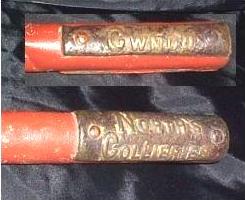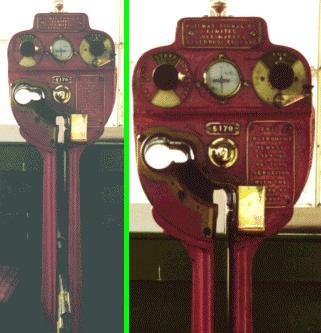What
was this Welsh Colliery key used for?
Can anyone let me
know what the following unusual item of South Wales Mining Memorabilia was
used for?
The
item in question being a very oddly designed key which is largely covered in
what appears to be an original coating of reddish/pink paint. The key measures
an enormous 25.5 inches long and principally comprises a long hollow steel
shaft of just under 1.5 inches in diameter. The tail of the shaft is plugged
with a brass insert while the head comprises a much smaller diameter shaft
(approximately 4.25 inches long) with a conventional key head attached to it.
Half way along the main shaft of the key is a strip of brass 5.3 inches long
moulded with four outer rings. A further brass ferrule ring is located a
quarter of the way up the key from the tip of its head. At the tail of the key
are two brass embossed name plates which have been riveted onto opposite sides
of its shaft. The first of these name plated bears the legend NORTH'S
COLLIERIES while the second simply reads CWMDU. For illustrations see
below;
Figure
1.0: Overall view of 25.5 inch long by 1.5 inch diameter colliery key.
Figure
2.0: Head end of key with its more conventional looking "business
end" measuring 4.25 inches long.
Figure
3.0: Central part of key showing brass strip and ferrule.

Figure
4.0: End views of name plates located at key's tail end. Legends read NORTH'S
COLLIERIES / CWMDU.
North's Navigation
Collieries (1899) Limited owned at least fifteen different coal and ironstone
levels in Cwmdu near Maesteg. Their operations in this area ran from 1899
until the time of the last level's closure in 1926. This relatively short
operating span date the manufacture of the key fairly precisely to a twenty
seven year period. The new owner of this unusual item of mining memorabilia
would welcome any information regarding its history plus suggestions as to the
purpose its unusual design once served.
Submitted By : A
South Wales Collector.
Date: January 2003
REPLY
No.1
The
item shown is a single line staff, carried by trains travelling between the
two locations marked on it (i.e. North's Collieries and Cumdu). There would
probably have been 20 to 30 of these, some in each of the signal boxes located
at the ends of a single line track (or block section) between the two stated
locations. The staffs were used as "tokens" as part of a fail safe
electrically interlocked signalling system. Such systems were introduced to
help prevent two or more trains from being permitted to travel in opposite
directions simultaneously on single line tracks.
The
electric train staff (or ETS) was developed in 1888 by the L & N W R and
licensed to the Railway Signal Co. This company had been formed by an
ex-employee of the L & N W R, one George Edwards, who had started his work
on signalling with Saxby & Farmer before becoming the signalling
superintendent of the L & N W R in 1873. In 1876 Edwards joined the
Gloucester Wagon Co. when they decided to diversify into signalling. He
finally set up his own company, the Railway Signal Co., in 1881. Not
surprisingly, he obtained a large number of contracts from the L & N W R
which led to the Railway Signal Co. becoming probably the most successful
signalling contractor in the 1890s. The function of the electric train staff
is simple, by means of having an instrument at each end of a block section,
electrically interlocked, just one staff at a time can be withdrawn (from
either end) and given to the driver as his authority, in conjunction with the
correct signals being off, to go on the single line. The staffs are made with
five rings which coincide with slots in the instrument, four of them at a set
spacing whilst the fifth is set at a different spacing from the instruments
for the sections on either side, thus preventing the staff for one section
being put in the instrument for another section. They all carry the names of
the block posts at either end of the section, and are painted in different
colours and distributed so that no one colour can ever apply to the staffs of
adjacent sections.

Examples
of ETS keys of the type patented in 1888 by F.W.Webb and A.M.Thompson of the
LNWR.
LNWR
staffs usually have a cast brass head, while those used by the GWR, LBSCR, and
some other companies have two brass nameplates or a sleeve fixed to the staff.
Length 23 inches (584 mm). Some large electric train staffs have an Annett's
key which was used for unlocking ground frames etc. The LNWR type of Annett's
key has small projections on the cast brass head whereas the others have a
key-like extension. The configuration of large staffs is determined by the
distance between the centre lines of the fourth and fifth rings, there was
also a colour code which was subject to local
variation:
| Configuration |
4th-5th
ring spacing |
Colour |
| A |
3
1/2 inches |
red |
| B |
3
inches |
blue |
| C |
2
1/2 inches |
green |
| D |
2
inches |
yellow |
The
signal box at each end of a block section of track (i.e. single line) was
equipped with a "token instrument". This was a machine which
detected the removal or replacement of a "staff" or
"token". The token was a metal key which was smaller than a staff
but which performed the same function. The token instruments at each end of a
single line section were electrically interlocked so that the act of removing
a token locked both machines and prevented further removals from either
instrument until the missing token was replaced at one end or the other. To
allow the passage of two or more consecutive trains in the same direction, the
system used more than one token. In effect, the "staff" and
"tickets" now became a set of metal tokens. In some systems, a set
of "staffs" were used as tokens. It worked like this: The signalbox
at each end of the line had lots of tokens. They were stored in the token
instrument. A token for authority for passage along a single line could only
be removed by the signalman at the departure end if the signalman at the
receiving end pressed a plunger which released the token on the departure end
instrument. When the token was removed from the instrument at the departure
end, the instruments at both ends became locked. Both remained locked until
the token was replaced in the receiving end instrument. If a second train had
to follow the first, a second token was released by the receiving end
signalman as before and removed from the departure end, locking both
instruments again until it was inserted in the instrument at the other end.
Because it was a system relying on electric locking it was called the electric
token system.
The
following is an account of how the ETS system still operates on the Bluebell
Railway, Greater London;
"The
method of use as practised on the Bluebell is as follows:- "A" and
"B" represent the Signalboxes at either end of a block section.
Prior to the despatch of a train from "A" the signalman there,
provided all other criteria have been met to send a train, must send the
appropriate "Is Line Clear" signal to the signalman at
"B". Assuming the signalman at "B" is able to accept the
train, having replied to "A's" bell signal "B" will hold
down his release key until the galvanometer needle, which will be deflected,
returns to the upright position, indicating that a staff has been withdrawn at
"A". When the signalman at "A" sees his galvanometer
needle deflect he must point his right-hand indicator to "For Staff"
and take out a staff which will mechanically repoint his right-hand indicator
to "For Bell". As soon as "A" has taken out a staff he
must turn the pointer on his left-hand indicator to "Down Staff Out"
if it is a down train, or "Up Staff Out" if it is an up train.
"B" must also turn his left-hand indicator to "Up Staff
Out" or "Down Staff Out" as the case may be. The signalman at
"A" will then lower his signals for the train to leave and hand the
staff to the driver. Once he has lowered his advanced starting signal he
cannot replace it and lower it again without replacing the staff in his
instrument and obtaining another release from "B". On arrival of the
train at "B" the signalman there must obtain the staff from the
driver and, after replacing his signals and checking that the train is
complete, insert it in his instrument and give "A" the "Train
Out of Section" signal which must be acknowledged. Both "A" and
"B" must now repoint their left-hand indicators to "Staff
In". Should it be necessary to replace a staff in the instrument from
which it was withdrawn, then the "Cancelling" signal must be sent to
the signalman at the other end of the section, and acknowledged. It is
frequently the case on other railways that the Release Key is also used for
belling (hence the "For Bell" position), but in the case of the
Bluebell a seperate bell plunger is used."

ABOVE
- Left. The Staff Instrument in Horsted Keynes Signalbox (Bluebell Railway).
Right. Close-up of the head of the Instrument. The staffs are kept in the slot
in the lower part of the Instrument and when one is required, it is lifted to
the top and, provided a release is being given by the signalman at the other
end, the relay will allow the cam inside to rotate thereby permitting the staff
to be withdrawn.
Based
on comments submitted By: Ron Cross (Webmaster of Railwayana Collectors
Network Web Site) plus his web article "British Single Line
Electric Train Tokens". Also information and pictures taken from the
Bluebell Railway Web Site.
Date:
April 2003
REPLY
No.2
North's
Navigation Collieries (1889) Ltd. was the major colliery company in the
Maesteg (Llynfi Valley) district from 1889 to nationalisation in 1947. The
company owned three large collieries in the Valley: Caerau, Coegnant, and St
John's (locally known as Cwmdu Colliery). The company's internal railway
system connected the collieries to the G.W. and Port Talbot railways serving
the district, and North's also had running powers over the G.W. and PT tracks.
St. John's Colliery was opened c.1910 and a mile long mineral railway was was
laid down connecting the colliery to the 'main -line' Port Talbot Railway at
Cwmdu Sidings. The key was probably used along that section of North's
Internal Railway.
Submitted
By: David Lewis (Swansea)
Date:
May 2003
REPLY No.3
The
item is indeed a single line train staff. It would have been used (as
described above) on a single line section of the Port Talbot Railway between
the two signal boxes of North's Collieries and Cwmdu close to Measteg.
The locations of these signal boxes are shown on map below.
Submitted By: Glenn Hopkins
Date: May 2006
If you can provide
any further information about the above item then please contact us via
the e-mail reply link below.
Previous
Home





